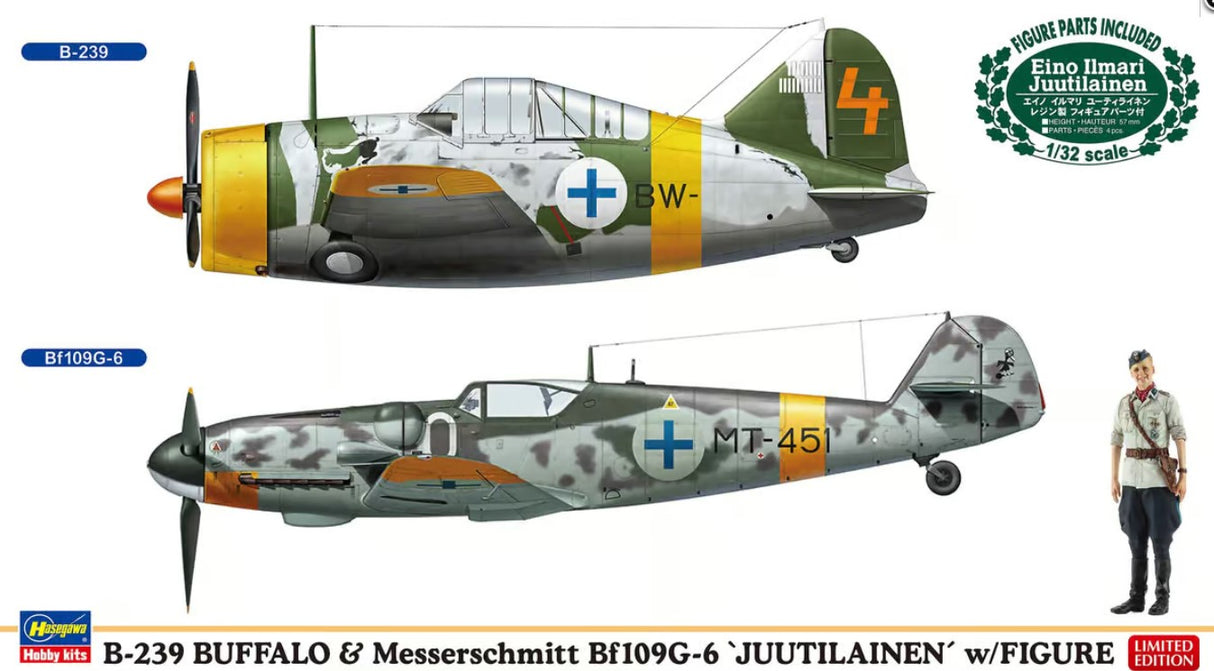Hasegawa 1:72 B-239 Buffalo and Messerschmitt Bf109G-6 - 2 kits in 1 box HA02439
Hasegawa 1:72 B-239 Buffalo and Messerschmitt Bf109G-6 - 2 kits in 1 box HA02439 will be backordered from our supplier. Delivery will take between 3-5 working days & orders will be despatched once completed.
Description
Description
Hasegawa 1:72 B-239 Buffalo and Messerschmitt Bf109G-6 - 2 kits in 1 box HA02439
Figure is included with kits
The Brewster B-239 was a Finnish mid-wing American production fighter from the interwar period and World War II. The flight of the prototype took place in 1937, and the machine entered the lines of the Finnish Air Force in 1939. The drive was usually provided by a single Wright R-1820-40 Cyclone engine with a capacity of 1200 HP. The deck armament consisted of four 12.7 mm Browning M2 machine guns.
Originally, the Brewster B-239 was designed for the US Navy as the Brewster F2A-1, to replace the Grumman F3F biplane. However, it was sold relatively quickly by the US Navy to the Finnish Aviation. The reason for this decision was that the US Navy was hoping to quickly receive a newer version of the machine, as well as the fact that Grumman F4F Wildcat fighters were to enter the line soon. The planes delivered to Finland were designated B-239E and a total of 44 machines of this type were delivered to Finland. They have also received new versions of the Wright Cyclone engines with a capacity of 1200 HP and the armour of the pilot's cabin. All types of instrumentation necessary for the service on aircraft carriers have also been removed from them. Aircraft of this type were not used during the Winter War (1939-1940), but were used on a large scale during the so-called The Continuation War (1941-1944), during which it gained the opinion of a reliable, manoeuvrable and durable fighter, showing great shooting statistics in clashes with Soviet machines. Interestingly, they remained with the Finnish air force until 1948!
The Messerschmitt Bf-109 is a German metal-structure single-engine fighter in a low wing configuration with a classic tail. It turned out to be the basic and most produced Luftwaffe fighter during World War II. The flight of the prototype took place on May 29, 1935, and serial production continued in the years 1936-1945. In total, it is estimated that a total of about 35,000 Messerschmitt Bf-109 fighters of all varieties were produced, many of which ended up in the Czech and Israeli air forces after the war. The roots of the Bf-109 go back to the competition announced in 1933 by the Luftwaffe for a new fighter plane. In competition with the He-112, the Bf-109 project initially lost, but thanks to Willie Messerschmitt's intrigues, the project could continue and eventually he was the winner of the competition, becoming the Luftwaffe's primary fighter. Several main variants of the Bf-109 were developed in the course of production. The first pre-production series was the Bf-109B (Berta) with different versions of the Junkers Jumo 210 (A or Da) engine. They were tested in Spain from 1937 during the Civil War. The next version is the Bf-109C (Caesar). They had a different engine than the B version, and extensive armament consisting of two 20mm and 2 HP 7.92mm cannons. These machines also fought in the skies of Spain. The third version is the Bf-109D (Dora) with the Junkers Jumo 210 Da or Daimler-Benz DB 600 engine. It fought in the September campaign, but at the turn of 1939/1940 it was replaced by the E version. The most famous model was the Bf-109E (Emil) with a Daimler-Benz 601A or N engine. It was the first to use a three-blade, not a two-blade propeller. Bf-109E fought in the French campaign, over England, and in North Africa and on the Eastern Front. The ace who started his career on the Bf-109E was the famous Adolf Galland. The next version is the Bf-109F (Friedrich), which, according to the German pilots, was the most aerodynamically perfect. It sowed the changed shape of the fuselage, wings, cabin fairings, but no new engine was used. It was put into service at the turn of 1940/1941. As part of the development of the design, further Bf-109 specifications were developed, of which the G (Gustav) version was produced in the largest number of copies. The most important change increasing the machine's performance was the installation of a new 12-cylinder Daimler-Benz DB605A engine with 1475HP. The armament of the Bf-109G was a pair of 13mm machine guns located in the fuselage in front of the cockpit fairing, and the MG151 20mm or heavier MK108 30mm cannon. The last mass-produced version was the Bf-109K (Kurfirst), which production started in October 1944. A Daimler-Benz DB 605DB or DC unit was used as the engine. The Bf-109K was the fastest version produced during World War II, reaching up to 730 km / h. Apart from that, two versions were created - H and Z, but they were rather experimental versions and their mass production did not start. Subsequent improvements in propulsion and armament made the Messerschmitt Bf-109 one of the most dangerous fighters of World War II, and at the same time showed the great potential of the slightly angular airframe created by Willi Messerschmitt. Technical data (version Bf-109 G-6): length: 8.95 m, wingspan: 9.92 m, height: 2.6 m, maximum speed: 640 km / h, rate of climb: 17 m / s, maximum range: 850 km, maximum ceiling 12000m, armament: fixed - 2 MG131 13mm machine guns and 1 MG151 20mm cannon, suspended - 250 kg bombs, or 2 Wfr missile launchers. Gr. 21.
Additional items required to complete kits:
Plastic Cement
Modelling knife or clippers
Paints
Paint Brushes
Brush Cleaner
Specifications
Specifications
Payment & Security
Payment methods
Your payment information is processed securely. We do not store credit card details nor have access to your credit card information.



